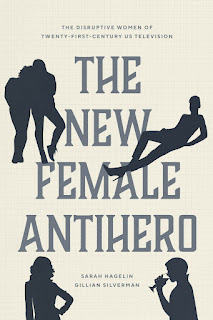 Reel Vulnerability: Power, Pain, and Gender in Contemporary American Film and Television. Gillian Silverman is associate professor of English and director of graduate studies at the University of Colorado Denver. She is the author of Bodies and Books: Reading and the Fantasy of Communion in Nineteenth-Century America.
Reel Vulnerability: Power, Pain, and Gender in Contemporary American Film and Television. Gillian Silverman is associate professor of English and director of graduate studies at the University of Colorado Denver. She is the author of Bodies and Books: Reading and the Fantasy of Communion in Nineteenth-Century America.
They applied the “Page 99 Test” to their new book, The New Female Antihero: The Disruptive Women of Twenty-First-Century US Television, and reported the following:
The first words on page 99 of The New Female Antihero concern the hysteric. Specifically, on this page we make the point that, in her emotional outbursts, Carrie Mathison of Homeland echoes the behaviors of the nineteenth-century hysterical woman. This woman represented “a rejection of traditional womanhood, insofar as her labile and erratic behavior meant that she couldn’t carry out her expected duties as selfless provider.” Something similar, we argue can be said about Carrie, whose bouts of mental instability are linked to her squalid apartment, her failure to get married, and her rejection of motherhood. While Carrie’s single state and less-than-pristine home are “logical consequences of long hours on a job important to national security, [her male colleagues] consistently treat them as signs of disordered gender.”Learn more about The New Female Antihero at the University of Chicago Press website.
These page 99 claims are an apt representation of the book as a whole. The New Female Antihero examines four dramas—Game of Thrones, The Americans, Scandal, Homeland—and four comedies—Girls, Broad City, Insecure, and SMILF—to make the case that the female protagonists of twenty-first century television are profoundly different from their predecessors. Earlier female-centered dramas like Cagney and Lacey and Ally McBeal, showcased women with strong moral compasses who were exceedingly good at their jobs. But in the antihero fare of the last ten years, women like Carrie Mathison engage in deeply unethical acts (killing innocents, sleeping with underaged men) and still find that the success they hope to gain eludes them. These women, we argue, reflect the victories and failures of liberal feminism. They are powerful figures deeply confident in their own abilities. And yet, one could hardly speak of theirs as feminist success stories given that they remain frustrated and mired in failure.
Having attempted and failed to achieve empowerment in the liberal feminist tradition—through striving, confidence, ambition, and physical strength—antiheroes like Carrie make room for the women of television comedy, who reject these values altogether (the subject of the second half of our book). Figures like Hannah Horvath of Girls, the broads of Broad City and Issa Dee of Insecure renounce aspirational goals, preferring to focus on indulgence and pleasure often in the company of female friends. Interestingly, page 99 contains a small commentary on this comedic figure. At the top of the page is an image of Anne Hathaway parodying Carrie Mathison for an episode of Saturday Night Live. It’s as if this page can already anticipate the direction the book is going: from women who strive and fail to women who stop striving and just make us laugh.
Marshal Zeringue



